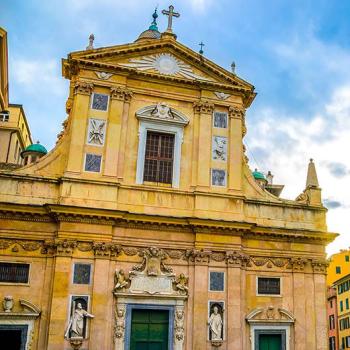EXPLORE LIGURIA FROM LA SPEZIA TO GENOA
Genova: the Superb city

As every port city, Genoa can be more appreciated above all arriving from the sea. And that’s from here the tall coloured houses of the old town appear us in all of their grandeur, with the hills to their shoulders each surmounted by a fortress.
Leaving from the Old Port the city enchants for the union between ancient and modern. Toward the sea, Renzo Piano’s works, the panoramic lift "Bigo", the Aquarium. On the other side, the charm of the ancient buildings, of the narrow streets called "carruggi" in which you can venture at the discovery of the largest historical centre in Europe.
A fierce republic, without Lords or Sovereigns, Genoa owes its glory to the experienced merchants and seamen that made it protagonist of the European economic scene during 16th and 17th Centuries. A walk through the centre brings you back to all of this: in 1550 the richest families in Genoa, the Spinolas, the Lomellinis, the Grimaldis, the Pallavicinos decided to furnish an example of the wealth of the city creating all
over again a road surrounded from luxury buildings, with fountains and nynphaeums at their entrances.
To do that it was called Galeazzo Alessi, capable architect with a great experience in Rome. The result, that enchanted the Flemish painter Rubens, is the today's Street Garibaldi (since 2006 UNESCO Heritage), called before "New Street."
A questo scopo fu chiamata Galeazzo Alessi, valente architetto formatosi a Roma. Il risultato, che incantò il pittore Fiammingo Rubens, è l’odierna Via Garibaldi (dal 2006 Patrimonio UNESCO), prima chiamata “Strada Nuova”.
The Buildings composing it are for the greatest part visitable, as the Galleries of Palazzo Bianco and Palazzo Rosso, housing paintings by Guido Reni, Artemisia and Orazio Gentileschi, Bernardo Strozzi, Anton Van Dyck, Luca Cambiaso, to quote only some of them.
But the beauty of Genoa doesn't exhaust here: from the several Churches, to the Ducal building, to the cathedral of St. Lawrence in Ligurian Gothic style, to the "edicole" (small votive niches set on the walls of the residences) every footstep can be a surprise, and is it not so bad to lose among the alleys of a city that still preserves the humours and the perfumes of all the people that here disembarked and from here departed. Genoa is also the city of the great steamboats, of the "Rex", of the "Andrea Doria", whose history and enterprises are reported in the Sea Museum.
And if during the walk you wish to have a break, what you need is following the inviting aroma of the focaccia, Slow Food aid and regional glory, and of the Pesto, very famous sauce made of basil, garlic, pine kerns, parmesan cheese, pecorino and perfumed Ligurian olive oil.
Leaving from the Old Port the city enchants for the union between ancient and modern. Toward the sea, Renzo Piano’s works, the panoramic lift "Bigo", the Aquarium. On the other side, the charm of the ancient buildings, of the narrow streets called "carruggi" in which you can venture at the discovery of the largest historical centre in Europe.
A fierce republic, without Lords or Sovereigns, Genoa owes its glory to the experienced merchants and seamen that made it protagonist of the European economic scene during 16th and 17th Centuries. A walk through the centre brings you back to all of this: in 1550 the richest families in Genoa, the Spinolas, the Lomellinis, the Grimaldis, the Pallavicinos decided to furnish an example of the wealth of the city creating all
over again a road surrounded from luxury buildings, with fountains and nynphaeums at their entrances.
To do that it was called Galeazzo Alessi, capable architect with a great experience in Rome. The result, that enchanted the Flemish painter Rubens, is the today's Street Garibaldi (since 2006 UNESCO Heritage), called before "New Street."
A questo scopo fu chiamata Galeazzo Alessi, valente architetto formatosi a Roma. Il risultato, che incantò il pittore Fiammingo Rubens, è l’odierna Via Garibaldi (dal 2006 Patrimonio UNESCO), prima chiamata “Strada Nuova”.
The Buildings composing it are for the greatest part visitable, as the Galleries of Palazzo Bianco and Palazzo Rosso, housing paintings by Guido Reni, Artemisia and Orazio Gentileschi, Bernardo Strozzi, Anton Van Dyck, Luca Cambiaso, to quote only some of them.
But the beauty of Genoa doesn't exhaust here: from the several Churches, to the Ducal building, to the cathedral of St. Lawrence in Ligurian Gothic style, to the "edicole" (small votive niches set on the walls of the residences) every footstep can be a surprise, and is it not so bad to lose among the alleys of a city that still preserves the humours and the perfumes of all the people that here disembarked and from here departed. Genoa is also the city of the great steamboats, of the "Rex", of the "Andrea Doria", whose history and enterprises are reported in the Sea Museum.
And if during the walk you wish to have a break, what you need is following the inviting aroma of the focaccia, Slow Food aid and regional glory, and of the Pesto, very famous sauce made of basil, garlic, pine kerns, parmesan cheese, pecorino and perfumed Ligurian olive oil.

Offers last minute
FIND OUT ABOUT THE SPECIAL OFFERS FOR YOU AT OUR CAMPSITES
SIGN UP TO OUR
Newsletter
Recommended by CampingVillage.Travel
Credits TITANKA! Spa





 GENOVA Max 28°
GENOVA Max 28°


 book
book
 quote
quote










